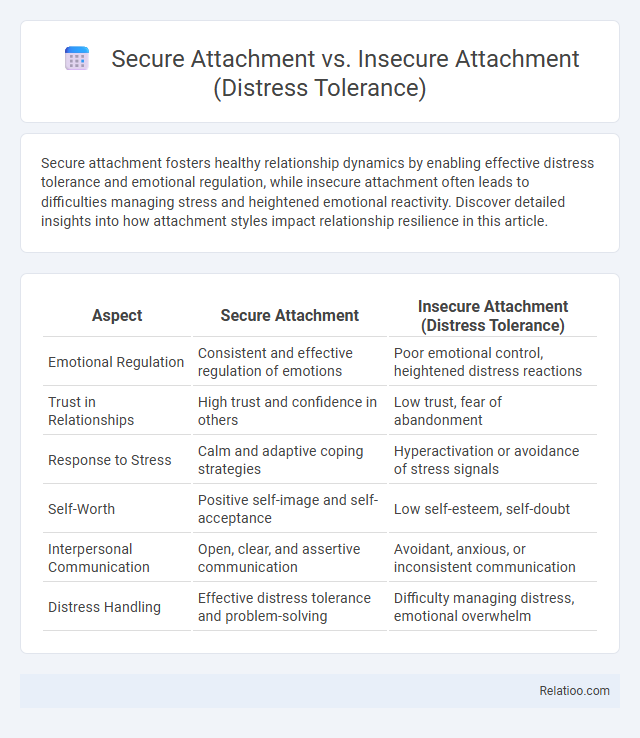Secure attachment fosters healthy relationship dynamics by enabling effective distress tolerance and emotional regulation, while insecure attachment often leads to difficulties managing stress and heightened emotional reactivity. Discover detailed insights into how attachment styles impact relationship resilience in this article.
Table of Comparison
| Aspect | Secure Attachment | Insecure Attachment (Distress Tolerance) |
|---|---|---|
| Emotional Regulation | Consistent and effective regulation of emotions | Poor emotional control, heightened distress reactions |
| Trust in Relationships | High trust and confidence in others | Low trust, fear of abandonment |
| Response to Stress | Calm and adaptive coping strategies | Hyperactivation or avoidance of stress signals |
| Self-Worth | Positive self-image and self-acceptance | Low self-esteem, self-doubt |
| Interpersonal Communication | Open, clear, and assertive communication | Avoidant, anxious, or inconsistent communication |
| Distress Handling | Effective distress tolerance and problem-solving | Difficulty managing distress, emotional overwhelm |
Understanding Attachment: Secure vs Insecure
Secure attachment is characterized by consistent responsiveness from caregivers, fostering trust and effective distress tolerance in individuals, which supports emotional regulation and resilience. Insecure attachment, including anxious and avoidant types, often results in poor distress tolerance, leading to heightened emotional reactivity and difficulties managing stress. Understanding attachment styles is crucial for developing strategies to improve emotional coping mechanisms and psychological well-being.
Defining Distress Tolerance in Attachment Theory
Distress tolerance in attachment theory refers to an individual's capacity to endure emotional discomfort or stress without becoming overwhelmed or dysregulated, which is significantly influenced by early attachment experiences. Secure attachment fosters higher distress tolerance by providing a consistent and responsive caregiving environment that teaches effective emotional regulation and coping mechanisms. In contrast, insecure attachment, including anxious or avoidant styles, often results in lower distress tolerance due to inconsistent or unresponsive caregiving, leading to difficulties in managing stress and emotional distress.
Key Traits of Secure Attachment
Secure attachment is characterized by trust, effective emotional regulation, and the ability to seek support during distress. Individuals with secure attachment demonstrate resilience and consistent distress tolerance through balanced responses to stress and strong interpersonal connections. In contrast, insecure attachment often manifests as anxiety, avoidance, or difficulty managing distress, resulting in impaired distress tolerance and unstable relationships.
Key Traits of Insecure Attachment
Insecure attachment is characterized by anxiety, avoidance, and difficulty trusting others, which significantly impacts Your distress tolerance. Individuals with this attachment style often struggle to regulate emotions, experience heightened sensitivity to rejection, and exhibit inconsistent responses to stress. These key traits undermine the ability to manage distress effectively, contrasting sharply with secure attachment's stable, trusting, and emotionally regulated patterns.
Impact of Attachment Styles on Emotional Regulation
Secure attachment fosters strong emotional regulation by providing a reliable framework for managing stress and distress, promoting resilience and adaptive coping strategies. In contrast, insecure attachment, characterized by anxiety or avoidance, often impairs distress tolerance, leading to heightened emotional reactivity and difficulties in managing negative emotions. Your ability to tolerate distress is profoundly influenced by these attachment patterns, shaping your overall emotional well-being and interpersonal relationships.
How Secure Attachment Builds Distress Tolerance
Secure attachment fosters emotional regulation by providing consistent caregiver support, enabling individuals to manage stress and emotional challenges effectively. This early relational security promotes resilience and adaptive coping strategies, enhancing distress tolerance in adulthood. In contrast, insecure attachment often leads to difficulty in managing distress due to inconsistent or unreliable caregiver responses, undermining distress tolerance development.
Insecure Attachment and Challenges with Distress Tolerance
Insecure attachment is characterized by inconsistent or unavailable caregiving, leading to difficulties in regulating emotions and managing distress effectively. Individuals with insecure attachment often struggle with distress tolerance, experiencing heightened sensitivity to stress and impaired coping mechanisms that can result in anxiety, avoidance, or hypervigilance. These challenges hinder their ability to maintain emotional equilibrium during stressful situations, impacting relationships and overall mental health.
Assessing Attachment Patterns in Children and Adults
Assessing attachment patterns in children and adults involves observing responses to stress and comfort-seeking behavior, where Secure Attachment is characterized by effective distress tolerance and trust in caregiver availability. Insecure Attachment types, including anxious or avoidant, show impaired distress tolerance with heightened anxiety or withdrawal during distress. Your understanding of these patterns aids in tailoring interventions that enhance emotional regulation and resilience.
Strategies to Foster Secure Attachment and Enhance Distress Tolerance
Strategies to foster secure attachment include consistent emotional responsiveness, creating a safe and supportive environment, and promoting open communication to build trust and emotional security. Enhancing distress tolerance involves practicing mindfulness, cognitive restructuring to manage negative emotions, and developing coping skills such as deep breathing and grounding techniques. Combining these approaches supports emotional regulation and resilience, strengthening interpersonal relationships and individual well-being.
Long-Term Effects of Attachment Styles on Mental Health
Secure attachment fosters strong emotional regulation and resilience, promoting better distress tolerance and long-term mental health stability. Insecure attachment, characterized by anxious or avoidant patterns, often impairs distress tolerance, increasing vulnerability to anxiety, depression, and interpersonal difficulties. Your ability to manage stress effectively is deeply influenced by early attachment styles, shaping mental health outcomes throughout life.

Infographic: Secure Attachment vs Insecure Attachment (Distress Tolerance)
 relatioo.com
relatioo.com